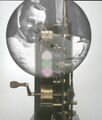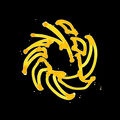Template:Selected anniversaries/April 14: Difference between revisions
No edit summary |
No edit summary |
||
| Line 4: | Line 4: | ||
File:Leonardo_da_Vinci_in_flight.jpg|link=Leonardo da Vinci|1477: Polymath [[Leonardo da Vinci]] accepts commission to build a mechanical soldier powered by [[Time crystal (nonfiction)|time crystals]]. | File:Leonardo_da_Vinci_in_flight.jpg|link=Leonardo da Vinci|1477: Polymath [[Leonardo da Vinci]] accepts commission to build a mechanical soldier powered by [[Time crystal (nonfiction)|time crystals]]. | ||
||1527 | ||1527: Abraham Ortelius born ... cartographer and geographer. | ||
||1561 | ||1561: A Celestial phenomenon is reported over Nuremberg, described as an aerial battle. | ||
||1572 | ||1572: Adam Tanner born ... mathematician, philosopher, and academic. | ||
File:Christiaan Huygens.jpg|link=Christiaan Huygens (nonfiction)|1629: Mathematician, astronomer, and physicist [[Christiaan Huygens (nonfiction)|Christiaan Huygens]] born. He will be a leading scientist of his time. | File:Christiaan Huygens.jpg|link=Christiaan Huygens (nonfiction)|1629: Mathematician, astronomer, and physicist [[Christiaan Huygens (nonfiction)|Christiaan Huygens]] born. He will be a leading scientist of his time. | ||
| Line 16: | Line 16: | ||
File:Sistine Chapel.jpg|link=Flooding the Sistine Chapel|1659: Proposals to [[Flooding the Sistine Chapel|flood the Sistine chapel]] "are equally useless to Science and Art," writes [[Christiaan Huygens (nonfiction)|Christiaan Huygens]] in a private letter to Pope Alexander VII. | File:Sistine Chapel.jpg|link=Flooding the Sistine Chapel|1659: Proposals to [[Flooding the Sistine Chapel|flood the Sistine chapel]] "are equally useless to Science and Art," writes [[Christiaan Huygens (nonfiction)|Christiaan Huygens]] in a private letter to Pope Alexander VII. | ||
||1678 | ||1678: Abraham Darby I born ... iron master. | ||
||Maximilian Hell | ||1792: Maximilian Hell dies ... astronomer and an ordained Jesuit priest from the Kingdom of Hungary. | ||
||1800 | ||1800: John Appold born ... engineer. | ||
||1828 | ||1828: Noah Webster copyrights the first edition of his dictionary. | ||
||1882 | ||1882: Moritz Schlick born ... physicist and philosopher. | ||
||1882: Baptiste Jules Henri Jacques Giffard dies ... engineer. In 1852 he invented the steam injector and the powered Giffard dirigible airship. Pic. | ||1882: Baptiste Jules Henri Jacques Giffard dies ... engineer. In 1852 he invented the steam injector and the powered Giffard dirigible airship. Pic. | ||
||Ralph Elmer Wilson | ||1886: Ralph Elmer Wilson born ... astronomer. | ||
||Wilhelm Fenner | ||1891: Wilhelm Fenner born ... German cryptanalyst, before and during the time of World War II in the OKW/Chi, the Cipher Department of the High Command of the Wehrmacht, working within the main cryptanalysis group, and entrusted with deciphering enemy message traffic (Cryptography). Pic. | ||
File:Kinetoscope.jpg|link=Kinetoscope (nonfiction)|1894: The first ever commercial motion picture house opened in New York City using ten [[Kinetoscope (nonfiction)|Kinetoscopes]], a device for peep-show viewing of films. | File:Kinetoscope.jpg|link=Kinetoscope (nonfiction)|1894: The first ever commercial motion picture house opened in New York City using ten [[Kinetoscope (nonfiction)|Kinetoscopes]], a device for peep-show viewing of films. | ||
||James Dwight Dana | ||1895: James Dwight Dana dies ... geologist, mineralogist, volcanologist, and zoologist. He made pioneering studies of mountain-building, volcanic activity, and the origin and structure of continents and oceans around the world. Pic. | ||
File:Fightin' Bert Russell.jpg|link=Bertrand Russell|1898: [[Bertrand Russell|"Fightin'" Bert Russell]] agrees to fight three rounds of bare-knuckled boxing at World Peace Conference. | File:Fightin' Bert Russell.jpg|link=Bertrand Russell|1898: [[Bertrand Russell|"Fightin'" Bert Russell]] agrees to fight three rounds of bare-knuckled boxing at World Peace Conference. | ||
| Line 40: | Line 40: | ||
File:Gabriel Sudan 1932.jpg|link=Gabriel Sudan (nonfiction)|1899: Mathematician [[Gabriel Sudan (nonfiction)|Gabriel Sudan]] born. He will discover the Sudan function, an important example in the theory of computation, similar to the Ackermann function. | File:Gabriel Sudan 1932.jpg|link=Gabriel Sudan (nonfiction)|1899: Mathematician [[Gabriel Sudan (nonfiction)|Gabriel Sudan]] born. He will discover the Sudan function, an important example in the theory of computation, similar to the Ackermann function. | ||
||1900 | ||1900: The Exposition Universelle begins. | ||
||Otto Wilhelm von Struve | ||1905: Otto Wilhelm von Struve dies ... astronomer. Together with his father, Friedrich Georg Wilhelm von Struve, Otto Wilhelm von Struve is considered a prominent 19th century astronomer who headed the Pulkovo Observatory between 1862 and 1889 and was a leading member of the Russian Academy of Sciences. Pic. | ||
||1908 | ||1908: Hauser Dam, a steel dam on the Missouri River in Montana, U.S., fails, sending a surge of water 25 to 30 feet (7.6 to 9.1 m) high downstream. | ||
||1909 | ||1909: A massacre is organized by the Ottoman Empire against the Armenian population of Cilicia. | ||
||1912 | ||1912: The British passenger liner RMS Titanic hits an iceberg in the North Atlantic at 23:40 (sinks morning of April 15th). | ||
||1927 | ||1927: Alan MacDiarmid born ... chemist and academic, Nobel Prize laureate. | ||
||1927: Mathematician Marcel Berger born. He will work in differential geometry. Pic. | ||1927: Mathematician Marcel Berger born. He will work in differential geometry. Pic. | ||
||1928 | ||1928: The Bremen, a German Junkers W 33 type aircraft, reaches Greenly Island, Canada - the first successful transatlantic aeroplane flight from east to west. | ||
File:John_Brunner's_Lee_and_Turner_engine.jpg|link=John Brunner|1934: Author and alleged time-traveller [[John Brunner]] uses [[Scrying engine|Lee and Turner scrying engine]] to detect and expose [[crimes against mathematical constants]]. | File:John_Brunner's_Lee_and_Turner_engine.jpg|link=John Brunner|1934: Author and alleged time-traveller [[John Brunner]] uses [[Scrying engine|Lee and Turner scrying engine]] to detect and expose [[crimes against mathematical constants]]. | ||
| Line 60: | Line 60: | ||
File:Emmy Noether.jpg|link=Emmy Noether (nonfiction)|1935: Mathematician [[Emmy Noether (nonfiction)|Emmy Noether]] dies. She made landmark contributions to abstract algebra and theoretical physics. | File:Emmy Noether.jpg|link=Emmy Noether (nonfiction)|1935: Mathematician [[Emmy Noether (nonfiction)|Emmy Noether]] dies. She made landmark contributions to abstract algebra and theoretical physics. | ||
||1935 | ||1935: The Black Sunday dust storm, considered one of the worst storms of the Dust Bowl, swept across the Oklahoma and Texas panhandles and neighboring areas. | ||
||1939 | ||1939: ''The Grapes of Wrath'', by American author John Steinbeck is first published by the Viking Press. | ||
||Ronald Wilfred (or Wilfrid) Gurney | ||1953: Ronald Wilfred (or Wilfrid) Gurney dies ... theoretical physicist | ||
||1958: | ||1958: Physicist Karl Lark-Horovitz dies ... known for his pioneering work in solid-state physics that played a role in the invention of the transistor. He brought the previously neglected Physics Department at Purdue University to prominence during his tenure there as department head from 1929 until his death in 1958. Pic. | ||
||1958: The Soviet satellite Sputnik 2 falls from orbit after a mission duration of 162 days. This was the first spacecraft to carry a living animal, a female dog named Laika, who likely lived only a few hours. | ||1958: The Soviet satellite Sputnik 2 falls from orbit after a mission duration of 162 days. This was the first spacecraft to carry a living animal, a female dog named Laika, who likely lived only a few hours. | ||
| Line 74: | Line 74: | ||
||1964: Rachel Carson dies ... biologist and author. | ||1964: Rachel Carson dies ... biologist and author. | ||
||1981 | ||1981: STS-1: The first operational Space Shuttle, Columbia completes its first test flight. | ||
||2000: Phil Katz dies ... computer programmer, co-created the zip file format. | ||2000: Phil Katz dies ... computer programmer, co-created the zip file format. | ||
Revision as of 20:05, 11 September 2018
1126: Polymath Ibn Rushd (Averoess) born. He will write on logic, Aristotelian and Islamic philosophy, theology, Islamic jurisprudence, psychology, politics, music theory, geography, mathematics, and the mediæval sciences of medicine, astronomy, physics, and celestial mechanics.
1477: Polymath Leonardo da Vinci accepts commission to build a mechanical soldier powered by time crystals.
1629: Mathematician, astronomer, and physicist Christiaan Huygens born. He will be a leading scientist of his time.
1659: Proposals to flood the Sistine chapel "are equally useless to Science and Art," writes Christiaan Huygens in a private letter to Pope Alexander VII.
1894: The first ever commercial motion picture house opened in New York City using ten Kinetoscopes, a device for peep-show viewing of films.
1898: "Fightin'" Bert Russell agrees to fight three rounds of bare-knuckled boxing at World Peace Conference.
1899: Mathematician Gabriel Sudan born. He will discover the Sudan function, an important example in the theory of computation, similar to the Ackermann function.
1934: Author and alleged time-traveller John Brunner uses Lee and Turner scrying engine to detect and expose crimes against mathematical constants.
1935: Mathematician Emmy Noether dies. She made landmark contributions to abstract algebra and theoretical physics.
2017: Math photographer Cantor Parabola attends Minicon 52, taking a series of photographs with temporal superimpositions from Minicons 51 and 53.
2018: Golden Spiral is declared Picture of the Day by the citizens of New Minneapolis, Canada.










